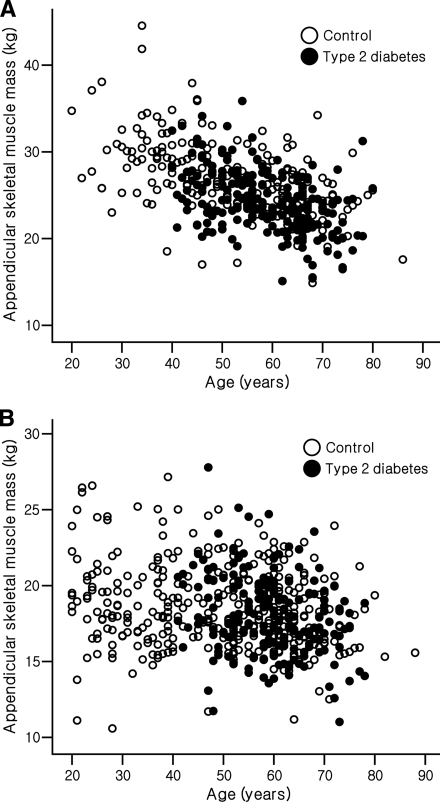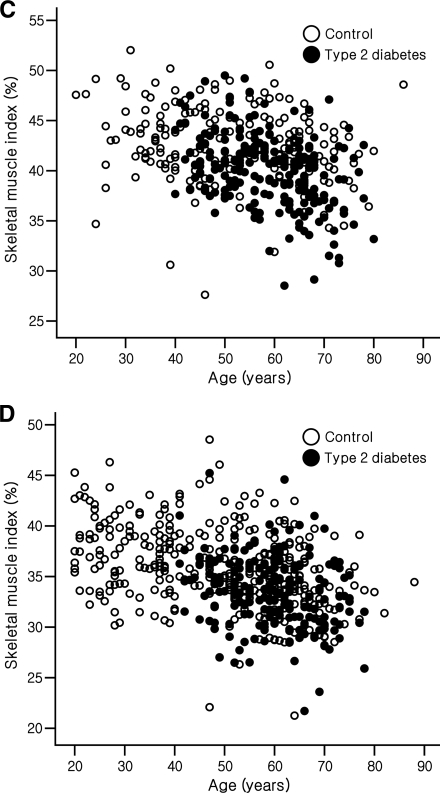Abstract
OBJECTIVE
We examined prevalence of sarcopenia in Korean patients with type 2 diabetes and compared body compositional parameters between subjects with and without type 2 diabetes.
RESEARCH DESIGN AND METHODS
The Korean Sarcopenic Obesity Study (KSOS) included 810 subjects (414 patients with diabetes and 396 control subjects) who were examined using dual-energy X-ray absorptiometry. Prevalence of sarcopenia was defined using the skeletal muscle index (SMI).
RESULTS
Prevalence in patients with diabetes and in the control group was 15.7 and 6.9%, respectively. In both men and women, SMI values were significantly decreased in patients with diabetes compared with subjects without diabetes. Furthermore, multiple logistic regression analysis showed that type 2 diabetes was independently associated with sarcopenia.
CONCLUSIONS
Type 2 diabetes was associated with increased risk of sarcopenia. These characteristics may contribute to physical disability and metabolic disorders in older adults with diabetes.
People in Asia tend to develop type 2 diabetes with less degree of obesity (1). In addition, Asian populations are more prone to abdominal obesity and low skeletal muscle mass (sarcopenia) with increased insulin resistance compared with their Western counterparts (2).
Type 2 diabetes is associated with lower skeletal muscle strength and quality as well as excessive loss of skeletal muscle mass in the Health, Aging, and Body Composition (Health ABC) study (3,4). Recently, we examined prevalence of sarcopenia in nondiabetic Korean adults and found that sarcopenic obesity defined using the skeletal muscle index (SMI (%): total skeletal muscle mass (kg)/weight (kg) × 100) was associated with increased risk of metabolic syndrome (5).
The aim of the current study was to examine prevalence of sarcopenia in Korean patients with type 2 diabetes and to compare body compositional parameters between subjects with and without diabetes.
RESEARCH DESIGN AND METHODS
The Korean Sarcopenic Obesity Study (KSOS) enrolled 446 well-functioning community-dwelling healthy volunteers without diabetes recruited from residents of Seoul, Korea, and 428 diabetic patients treated at the Diabetes Center of Korea University Guro Hospital. Analysis was conducted on 810 subjects (414 patients with type 2 diabetes and 396 control subjects) who were examined using dual-energy X-ray absorptiometry (Hologic Discovery A; Hologic, Bedford, MA). Medical histories and lifestyle information were collected by personal interview using a detailed questionnaire (6). The Korea University Institutional Review Board approved this study protocol.
Appendicular skeletal muscle mass (ASM), ASM/height2, and SMI were performed as previously described (7–10). Sarcopenia was defined as SMI <2 SD below the mean of the young reference group (see supplementary Table 2, available in an online appendix at http://care.diabetesjournals.org/cgi/content/full/dc09-2310/DC1). We previously established cutoff values for sarcopenia (5). Further information on study design and methods is given in the online appendix.
RESULTS
Figure 1 presents the scatter plots for the association between age and ASM and SMI, according to sex and diabetes status. Total lean body mass and SMI in men with diabetes were lower than in control subjects after adjustment for covariates such as age, BMI, health-related behaviors, medication, and metabolic parameters. In women, ASM/height2 and SMI in patients with diabetes were lower than in nondiabetic counterparts (supplementary Table 1).
Figure 1.
Relationships between age and appendicular skeletal muscle mass (A: men; B: women) and skeletal muscle index (C: men; D: women) across category of type 2 diabetes for each sex in the study subjects.
Prevalence of sarcopenia in patients with diabetes and in the control group was 15.7 and 6.9%, respectively. In subjects older than 60 years, prevalence of sarcopenia was greater in both men and women with diabetes than in nondiabetic counterparts (19.0 vs. 5.1%, P = 0.005, in men and 27.0 vs. 14.0%, P = 0.013, in women). However, in the middle-aged group (age 40–59 years), a significant difference in prevalence of sarcopenia between groups with and without diabetes was observed only in women (16.7 vs. 4.1%, P = 0.002) (supplementary Table 3). Patients with diabetes had three times higher risk of sarcopenia (odds ratio 3.06, 95% CI 1.42–6.62) than subjects without diabetes after adjusting for age, sex, BMI, smoking, alcohol drinking, physical activity, medications, blood pressure, and lipid profiles (supplementary Table 4).
CONCLUSIONS
In the present study, we first examined prevalence of sarcopenia in patients with type 2 diabetes, and the present study showed that men with diabetes had decreased lean body mass and increased body fat mass, even though they had similar BMI compared with nondiabetic subjects. Moreover, compared with nondiabetic counterparts, both men and women with diabetes had decreased SMI values. However, in a cross-sectional analysis of the Health ABC study that included Western elderly subjects, patients with type 2 diabetes exhibited increases in both lean body mass and body fat mass compared with subjects without diabetes, because, compared with nondiabetic subjects, those with diabetes were more obese and had higher BMI (3). Alternatively, this study reported that individuals with diabetes had either weaker (men) or not stronger (women) muscle strength than individuals without diabetes despite larger muscle mass. This difference of sarcopenia between Asian patients and Western patients with type 2 diabetes might originate from ethnic differences in characteristics of type 2 diabetes.
Interestingly, middle-aged women as well as elderly women with diabetes exhibited higher prevalence of sarcopenia than individuals without diabetes, despite this difference not being significant in middle-aged men. Our findings are in agreement with several previous studies demonstrating that men lose greater skeletal muscle mass with aging, even though they have greater skeletal muscle mass than women (11,12) and that women with diabetes are at particularly high risk for loss of skeletal muscle mass (4). These results imply that type 2 diabetes is an important predictor of sarcopenia, particularly in women, and that this relationship in men is mainly restricted to elderly people.
A limitation of this study was that our study was performed using baseline data from an ongoing prospective cohort study. Therefore, it is not possible to impute causality. However, we are performing a follow-up survey to explore the longitudinal interrelationship between diabetes and sarcopenia in Korean adults.
In conclusion, the present study showed that prevalence of sarcopenia was higher in Korean patients with type 2 diabetes, particularly in women and the elderly. Furthermore, type 2 diabetes was independently associated with increased risk of sarcopenia after adjusting for potential risk factors. These results suggest that patients with type 2 diabetes are at risk of developing sarcopenia.
Supplementary Material
Acknowledgments
This study was supported by the Korea Science and Engineering Foundation (KOSEF) grant funded by the Korea government (R01-2007-000-20546-0) and a grant of the Korean Health 21 R&D Project, Ministry of Health & Welfare, Republic of Korea (A 050463).
No potential conflicts of interest relevant to this article were reported.
T.N.K. and K.M.C researched data, contributed to discussion, wrote the manuscript, and reviewed/edited the manuscript. M.S.P., S.J.Y., H.J.Y., H.J.K., W.S., J.A.S., S.G.K., N.H.K., and S.H.B. researched data, contributed to discussion, and reviewed/edited the manuscript. D.S.C. researched data and reviewed/edited the manuscript.
Footnotes
The costs of publication of this article were defrayed in part by the payment of page charges. This article must therefore be hereby marked “advertisement” in accordance with 18 U.S.C. Section 1734 solely to indicate this fact.
References
- 1. Yoon KH, Lee JH, Kim JW, Cho JH, Choi YH, Ko SH, Zimmet P, Son HY: Epidemic obesity and type 2 diabetes in Asia. Lancet 2006; 368: 1681–1688 [DOI] [PubMed] [Google Scholar]
- 2. Chan JC, Malik V, Jia W, Kadowaki T, Yajnik CS, Yoon KH, Hu FB: Diabetes in Asia: epidemiology, risk factors, and pathophysiology. JAMA 2009; 301: 2129–2140 [DOI] [PubMed] [Google Scholar]
- 3. Park SW, Goodpaster BH, Strotmeyer ES, de Rekeneire N, Harris TB, Schwartz AV, Tylavsky FA, Newman AB: Decreased muscle strength and quality in older adults with type 2 diabetes: the health, aging, and body composition study. Diabetes 2006; 55: 1813–1818 [DOI] [PubMed] [Google Scholar]
- 4. Park SW, Goodpaster BH, Lee JS, Kuller LH, Boudreau R, de Rekeneire N, Harris TB, Kritchevsky S, Tylavsky FA, Nevitt M, Cho YW, Newman AB: Excessive loss of skeletal muscle mass in older adults with type 2 diabetes. Diabetes Care 2009; 32: 1993–1997 [DOI] [PMC free article] [PubMed] [Google Scholar]
- 5. Kim TN, Yang SJ, Yoo HJ, Lim KI, Kang HJ, Song W, Seo JA, Kim SG, Kim NH, Baik SH, Choi DS, Choi KM: Prevalence of sarcopenia and sarcopenic obesity in Korean adults: the Korean sarcopenic obesity study. Int J Obes (Lond) 2009; 33: 885–892 [DOI] [PubMed] [Google Scholar]
- 6. Salti I, Bénard E, Detournay B, Bianchi-Biscay M, Le Brigand C, Voinet C, Jabbar A. EPIDIAR study group. A population-based study of diabetes and its characteristics during the fasting month of Ramadan in 13 countries: results of the epidemiology of diabetes and Ramadan 1422/2001 (EPIDIAR) study. Diabetes Care 2004; 27: 2306–2311 [DOI] [PubMed] [Google Scholar]
- 7. Heymsfield SB, Smith R, Aulet M, Bensen B, Lichtman S, Wang J, Pierson RN, Jr: Appendicular skeletal muscle mass: measurement by dual-photon absorptiometry. Am J Clin Nutr 1990; 52: 214–218 [DOI] [PubMed] [Google Scholar]
- 8. Baumgartner RN, Koehler KM, Gallagher D, Romero L, Heymsfield SB, Ross RR, Garry PJ, Lindeman RD: Epidemiology of sarcopenia among the elderly in New Mexico. Am J Epidemiol 1998; 147: 755–763 [DOI] [PubMed] [Google Scholar]
- 9. Kim J, Wang Z, Heymsfield SB, Baumgartner RN, Gallagher D: Total-body skeletal muscle mass: estimation by a new dual-energy X-ray absorptiometry method. Am J Clin Nutr 2002; 76: 378–383 [DOI] [PubMed] [Google Scholar]
- 10. Janssen I, Heymsfield SB, Ross R: Low relative skeletal muscle mass (sarcopenia) in older persons is associated with functional impairment and physical disability. J Am Geriatr Soc 2002; 50: 889–896 [DOI] [PubMed] [Google Scholar]
- 11. Janssen I, Heymsfield SB, Wang ZM, Ross R: Skeletal muscle mass and distribution in 468 men and women aged 18–88 yr. J Appl Physiol 2000; 89: 81–88 [DOI] [PubMed] [Google Scholar]
- 12. Gallagher D, Visser M, De Meersman RE, Sepúlveda D, Baumgartner RN, Pierson RN, Harris T, Heymsfield SB: Appendicular skeletal muscle mass: effects of age, gender, and ethnicity. J Appl Physiol 1997; 83: 229–239 [DOI] [PubMed] [Google Scholar]
Associated Data
This section collects any data citations, data availability statements, or supplementary materials included in this article.




